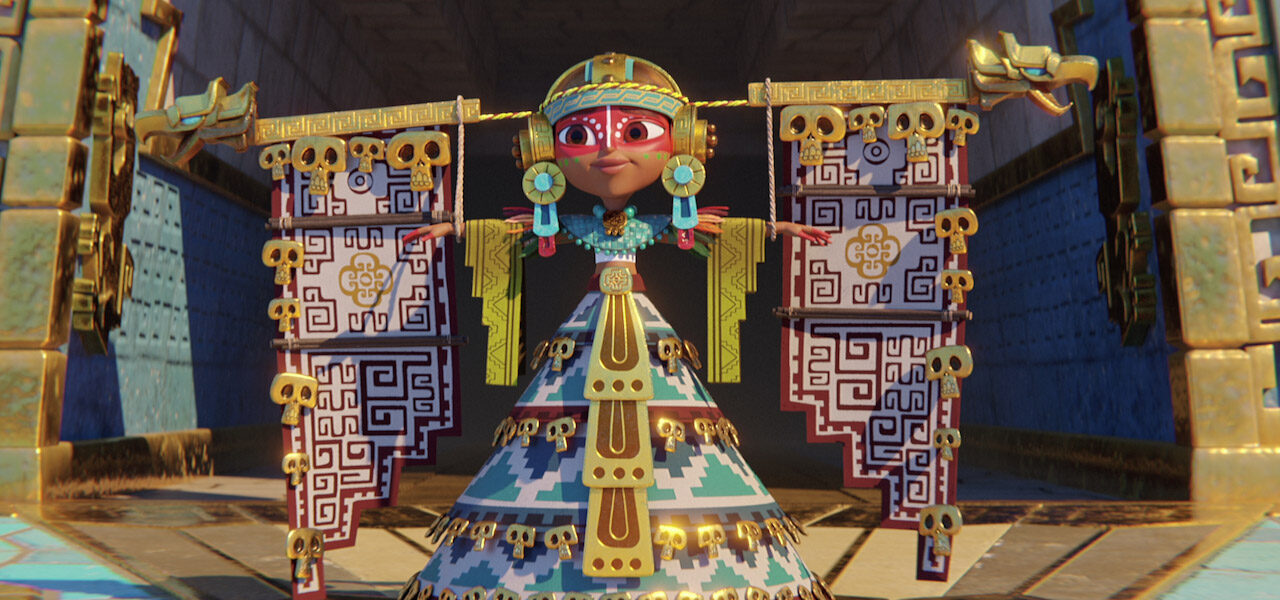

Series Craft: Designing The Elaborate Costumes In ‘Maya And The Three’
Friday saw Netflix launch Maya and the Three, a limited series with the production values of a feature and the rich design work by now familiar to fans of Jorge Gutiérrez.
The story follows Maya, a young warrior princess, as she quests through fantastical realms teeming with gods, royals, and other whimsical characters. The universe draws deeply on Mesoamerican mythology, though diverse visual influences are mixed in, from pulp sword and sorcery characters to Miss Universe pageants.
The whole is refracted through Gutiérrez’s bold, geometric design sensibility that builds on his earlier works, such as El Tigre and The Book of Life. He collaborated on those projects with his wife, fellow character designer Sandra Equihua; they teamed up again to create the characters in Maya and the Three, Gutiérrez focusing on the men, Equihua on the women.
Below, the pair tell us how they designed five characters from Maya and the Three, focusing on the dazzling costumes — one of the show’s most eye-catching elements. Their comments are accompanied by development artwork.
Maya in Coronation Dress
Jorge Gutiérrez: For this crazy dress we looked at Mexico’s “national costumes” over the years for the Miss Universe pageant, which are sometimes ridiculously over the top. Mexico has won three times! The headdress was inspired by Montezuma’s headdress, who was the Aztec emperor at the time of the Spanish conquest. This is not an outfit that reflects Maya’s character at all so we pushed that idea.

Sandra Equihua: This scene is Maya’s coronation as well as a tip of the hat to traditional quinceañeras, which are representative of a transition in a young girl’s life from childhood to adulthood. Where dresses used to only be white for quinceañeras, nowadays they go to extremes to be unique and extravagant in color or design. But as a common rule, they’re usually humongous. We wanted to take this idea and go crazy with it!
King Teca
Gutiérrez: I wanted this bad hombre to look like a crazy Aztec tank! I was very inspired by the traditional Aztec Eagle Warrior sculptures I saw at the Templo Mayor and Museo Nacional de Antropología in my hometown of Mexico City. And the epic Eagle Warrior paintings of Jorge González Camarena, especially El abrazo and La fusión de dos culturas. I was also inspired by a design I saw on the side of a taco truck after a night of tequilas in Tijuana!


Gutiérrez: [When drawing inspiration from traditional Mesoamerican designs,] we were always super respectful and did a ton of research. We also studied modern reinterpretations in Mexican tattoos, urban murals, and popular culture in Mexico. Since we’re both Mexican (and mestizos, meaning mixed blood) we really allowed ourselves to be magical, whimsical, and experimental. I believe artists will always help culture evolve and this is our personal fantasy reinterpretation of these worlds.
Barbarian Princess
Equihua: We decided to use warm colors and patterns paying homage to various textiles and symbols found in ancient Incan culture. The symbolism of the pumas is very specific to our magical world.
Her father, the Barbarian King (designed by Jorge), is a towering hulking mass, so I thought using a slender design for the Barbarian Princess would be ideal to make him look even more intimidating (which is kind of funny, because he’s very childlike in many aspects, but will still chop your head off if angry!).

Gutiérrez: [As the designs transition to 3d models, the costumes are tweaked] much less than you think! I love to design characters and don’t have a director or producer above telling me to simplify! Sandra’s beautifully graphic character designs tend to be more streamlined and my biggest note is always, “I want more crazy please!”
Money and time are the real limitation: we had to minimize the amount of arms, hair, and cloth to stay on budget. Before I started at Netflix, I hired Esteban Pedrozo (in Paraguay) to do ZBrush versions of the characters of Maya and “the Three” (Rico, Chimi, and Picchu) to sell what they would look like to everyone. And the final production versions done by the brilliant team at Tangent Animation were extremely close to that.

Chimi
Gutiérrez: Since “the Three” are inspired by the Scarecrow, the Tinman, and the Lion from The Wizard of Oz, Chimi is sort of the Tinwoman. This kingdom worships Lady Micte, a fantasy goddess of death, and Chimi is her biggest fan. Chimi was born with Albinism (and was outcast for this) so she paints herself differently than everyone else.
Equihua: Chimi’s design was conceived to create a contrast with Maya’s stature. While Maya is petite and curvy (like her club), Chimi is long and svelte (like her arrows). There is an elegance to her persona while Maya’s design creates a juxtaposition to Chimi with her stout legs and the way she moves.


Lord Mictlan
Gutiérrez: I figured I would only get one chance in my life to design my own fantasy version of a Mesoamerican god of war, so I wanted to go all out and be a bit metal. The two skull heads represent the idea that war is about two endlessly opposing forces.

Gutiérrez: I referenced the ancient images of both Huitzilopochtli (Aztec god of war) and Ek Chuaj (Mayan god of war, human sacrifice, and violent death!). Also the Skeletor paintings from the He-Man 1980s toy boxes, Lord Humongous (from Mad Max 2: The Road Warrior), La Parka (a skull-themed masked luchador), and Thulsa Doom (from Conan the Barbarian).
